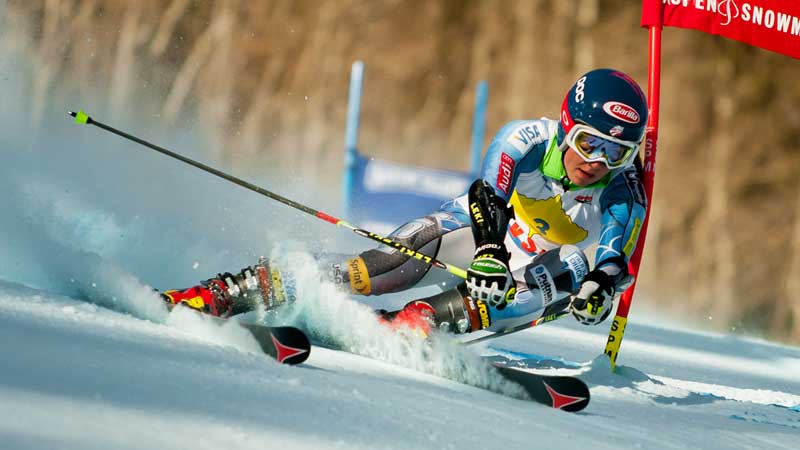Four years ago, the current reigning world-champion slalom skier Mikaela Shiffrin, then all of 14, realized timing was everything. The more she skied slalom, ski racing’s most technical event, the more she felt a unique tempo. She honed in on the sound of the gates hitting the snow. She heard a beat—usually drums, but sometimes the rhythmic strumming of a guitar. “Tempo” became her trigger word.
 Check out our slideshow of the young skiing phenom.
Check out our slideshow of the young skiing phenom.“If anyone said ‘tempo’, I’d search for that correct feeling,” says Shiffrin. “I wasn’t worried about the technical movements; I was just looking for perfect timing. It changes with every course, but I’ve gotten to the point where I can inspect the course and feel the tempo before I ski it.”
On January 14, 2014, Shiffrin race of the season, solidifying her position as Olympic favorite in the event. The 18-year-old has also podiumed twice in giant slalom this season, another discipline in which she’s a viable medal contendar in Sochi. Last season, her second on the World Cup circuit, Shiffrin won the slalom race at the world championships in Schladming, Austria, becoming the fourth youngest woman—and just third non-European—to win the World Cup Slalom title. Oh, and she also graduated high school from Vermont’s Burke Mountain Academy.
Off the slopes, the rosy cheeked, curly haired American teen looks as wholesome as her friends describe her.
“She’s the epitome of a normal girl,” says her BMA roommate Brayton Pech. “She’s not afraid to make fun of herself. She doesn’t swear. She does these great impressions from Pixar movies. She loves to nap. She’s a good listener. She’s never fake… she’s exactly who she is.”
But when it comes to owning technical ski races, she’s all focus and hard work. “I’m not the most athletic person,” Shiffrin says. “Sports are in my genes, but there are a lot of other girls who I’ve gone up against who are better athletes—they’re stronger, bigger, faster, scrappier, and mentally tougher.”
But nothing could deter Shiffrin from improving. She was—and still is—hell bent on becoming tangibly better everyday.
“I’m always hungry to ski,” she says. “There are times when I do need a day off but it’s because I’m fatigued, not because I don’t want to put my boots on.”
At BMA, a small boarding school with a ski-racing emphasis (alum include Erik Schlopy and Diann Roffe), Shiffrin was usually the first one on the hill, warming up and helping set the course. After training, she’d ski another five runs on her own, working on various drills to perfect her technique.
“She’s a student of skiing,” says Kirk Dwyer, her coach at BMA, who Shiffrin credits with establishing her work ethic. “She’s probably spent more time analyzing video than any skier out there.”
Pech remembers a powder day when class was cancelled. After a few runs, Shiffrin disappeared.
“I was on the chairlift and looked over at our training hill. Half the fencing was covered in snow and Mikaela was doing drills on her Super G skis. What most of us see as work, she sees as fun.”
Shiffrin’s parents, Jeff and Eileen, noticed her talent early on. “She had the fundamentals dialed by the time she was six,” says Eileen. “She was already arcing these awesome turns.”
In 2003, her family left Vail, Colorado, for New England, where Shiffrin and her older brother Taylor enrolled at Burke. A brief stint back in Colorado proved to Shiffrin that the east coast, with its challenging conditions and efficient vertical, was the optimal place to develop as a ski racer. Her modus operandi: high volume.
“There are few skiers who can ski the amount Mikaela skis,” says Dwyer.
When she was 14, while most of her peers were competing in up to 30 races a season, Shiffrin only raced a dozen times. Instead of traveling to races around the country and skiing two timed runs, she skied all day, everyday, working on her technique.
“At that stage, and even now, I need a lot of training,” says Shiffrin. “I’m racing with girls who have 10 years mileage on me, so I have to take every chance to train.”
Shiffrin explains that because 60-second runs take up a small portion of a typical five-hour training day, a lot of her time revolves around visualization.
“You can pretty much simulate training,” she says. “If you visualize well enough, your brain can’t tell between skiing and visualizing. Then, you can get double or triple the amount of training.”
Shiffrin started her first World Cup race at the age of 15. Two years later, she won her first World Cup race in Are, Sweden, becoming the second-youngest American ever to win an alpine World Cup event. Instead of traveling with the U.S. Ski Team—and teammates ten years her senior—Mikaela chose to travel the World Cup circuit with her mom. Eileen has spent the last two winters driving around the Alps with her daughter, taking care of meals and laundry, and helping her study and complete high school while on the road. She even plays a coach’s role from time to time.
“She has a good eye,” says Shiffrin. “If I have a tough day I can look at video with her and we can start to figure out what happened. It’s been like that ever since I can remember.”
With Shiffrin’s work ethic and determination, she most likely could have succeeded in a number of sports. But when her coach recently asked her why she didn’t pursue soccer, she answered confidently:
“I’m a ski racer. That’s how I identify myself, with skis strapped to my feet.”


